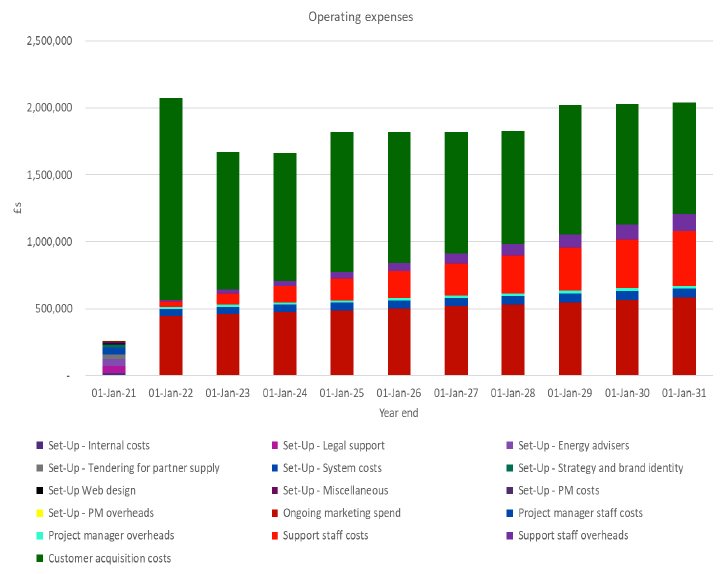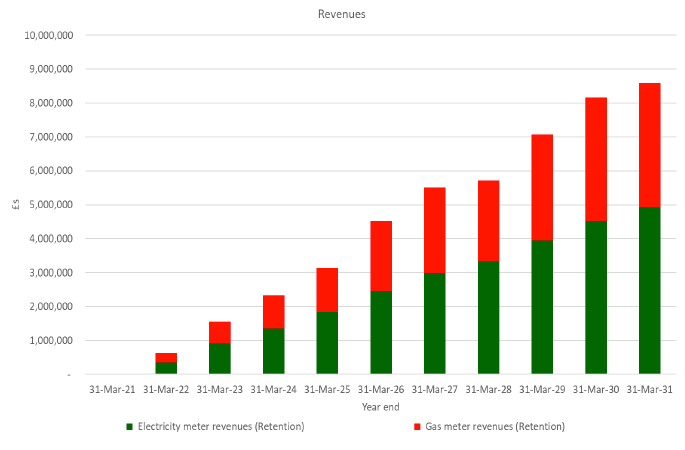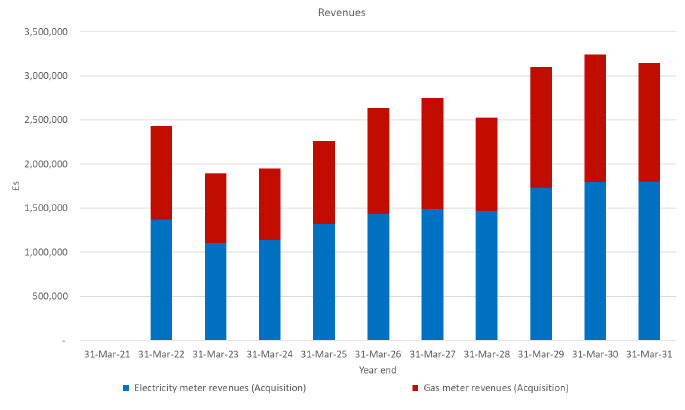Public energy company: outline business case
An independent outline business case for a national public energy company.
11 Appendix D – Financial Modelling Assumptions
Operating costs (Opex)
The costs of operating the Public Energy Company are limited due to the selection of a White Label company as the preferred option. In a company set up in this manner, many of the costs of operation are borne by the third-party energy supplier, for example, customer service and infrastructure costs. The table below shows the annual operating costs of the Public Energy company, the assumptions column provides an explanation of the formation of the cost. All cost assumptions have RPIx applied to them in the Financial Model. In order to present a 'rounded' view of the costs of establishing the Public Energy Company, we have included the set-up cost assumptions. For both the Acquisition Model and the Retention Model the same underlying operating costs are assumed.
| Cost type | Value Core £ |
Value Optimistic £ |
Value Pessimistic £ |
|---|---|---|---|
| Set-up costs | |||
| Internal costs | £20,000 | £15,000 | £35,000 |
| Legal support | £50,000 | £40,000 | £75,000 |
| Energy advisers | £50,000 | £40,000 | £75,000 |
| Tendering for partner supply | £35,000 | £25,000 | £50,000 |
| System costs | £50,000 | £25,000 | £100,000 |
| Sub-total – Set-up costs | £205,000 | £145,000 | £335,000 |
| Marketing costs (incurred during set-up phase) | |||
| Strategy and brand identity | £20,000 | 15,000 | 30,000 |
| Web design | £8,000 | 5,000 | 15,000 |
| Set-up / Miscellaneous | £15,000 | 10,000 | 20,000 |
| Sub-total – marketing (set-up) costs | £43,000 | 35,000 | 65,000 |
| Ongoing operating costs | |||
| Ongoing marketing spend | £420,000 per annum | £360,000 per annum |
£520,000 per annum |
| Project Manager / Co-ordinator costs | £65,000 per annum | £65,000 per annum | £65,000 per annum |
| Support staff costs | £26,000 per annum (1 required per 20,000 customers) | £26,000 per annum (1 required per 22,000 customers) | £26,000 per annum (1 required per 15,000 customers) |
| Customer acquisition cost – single meter | £20.00 per customer | £12.50 per customer | £22.50 per customer |
| Customer acquisition cost – duel fuel | £30.00 per customer | £22.50 per customer | £37.50 per customer |
The figure below demonstrates the operating expenses incurred on an annual basis, incorporating the impact of indexation.

Revenues
Revenues for the Public Energy Company are comprised of income from fees earned from the White Label Supplier to the Public Energy Company. In the retention model, these are provided as a one-off value on an initial sign-up basis. In the acquisition model, the Public Energy Company is assumed to received ongoing retention fees on a monthly basis. The two figures below demonstrate the annual revenues under each set of core assumptions that have been assumed for the Project.


Retention model - ongoing retention fees
Under the Retention model, we have assumed that the Public Energy Company will come to a contractual arrangement with the White Label energy supplier, whereby the supplier pays the Public Energy Company an agreed amount for each month that a customer remains with the Public Energy Company. This will have the benefit to the Public Energy Company of providing a (relatively) stable monthly income stream that can be used to subsidise activities. From the Public Energy Companies perspective, it also encourages Scottish Government to seek an agreement with an energy supplier that will prioritise quality of service delivery, as a satisfied customer is less likely to switch energy supplier.
The table below demonstrates the level of retention fees forecast under the core, optimistic and pessimistic scenarios.
| Revenue type | Value Core |
Value Optimistic |
Value Pessimistic |
|---|---|---|---|
| Amount received from energy supplier – first meter connected (assumed to be electricity) | £1.00 per month | £1.10 per month | £0.80 per month |
| Amount received from energy supplier – two meters connected (i.e. both electricity and gas connection assumed) | £2.00 per month | £2.20 per month | £1.60 per month |
| Percentage of customers assumed to be dual fuel (i.e. signing up with two meters) | 69.45% | 69.45% | 69.45% |
Acquisition model - initial sign-up fees
As an alternative to the Retention model, the contractual arrangement that the Public Energy Company comes to with the White Label energy supplier may be on an 'acquisition' basis. Under this model, the energy supplier pays the Public Energy Company a one-off payment for each customer that the Public Energy Company are able to sign up. This approach has the benefit of providing significant up-front cash inflows to the Public Energy Company (although it is recognised that in reality there may be a 'claw back' if a newly signed up customer does not stay with on their tariff for an agreed period).
The table below demonstrates the acquisition fees forecast under the core, optimistic and pessimistic scenarios.
| Revenue type | Value Core |
Value Optimistic |
Value Pessimistic |
|---|---|---|---|
| Amount received from energy supplier – first meter connected (assumed to be electricity) | £25.00 one-off |
£30.00 one-off |
£20.00 one-off |
| Amount received from energy supplier – two meters connected (i.e. both electricity and gas connection assumed) | £50.00 one-off |
£30.00 one-off |
£20.00 one-off |
| Percentage of customers assumed to be dual fuel (i.e. signing up with two meters) | 69.45% | 69.45% | 69.45% |
Funding
The funding structure for the Public Energy Company reflects the current thinking. Through the Commercialisation and Procurement phases this will need to be developed further in light of the final agreed procurement route and structure of the SPV.
The core scenarios assume that a Public Energy Company in the form of a company limited by shares will be established, into which investors can make a pinpoint equity investment in proportion to their ownership. The quantum of this amount reflects that it is not the principal source of funding for the Public Energy Company and is at sufficient levels to establish the Public Energy Company. This is therefore £1,000 for each investor into the Public Energy Company. Cash surpluses for funding initiatives aimed at reducing fuel poverty, will be paid out of the Public Energy Company in accordance with the ownership structure.
As noted in the Commercial Case, further legal advice should be sought to ensure an appropriate commercial vehicle is selected. In particular, the results presented in this Financial Case include the impact of corporation tax on the trading profits of the Public Energy Company. Should the commercial arrangement be set up such that the Public Energy Company is established as a charitable entity with a trading subsidiary, there is a potential that these trading profits could be paid via gift aid to the charity for use in charitable activities, thus obviating the need to pay corporation tax. The need for flexibility in future would however need to be considered if this approach was to be pursued, and how this may impact on future intentions of the Public Energy Company
The development and initial operational requirements of the Public Energy Company are structured to be met through an issue of debt to the company. This is set at a level to provide sufficient working capital such that e.g. an overdraft is not required in addition to this amount.
For the avoidance of doubt, the core, optimistic, and pessimistic scenarios all have the initial provision of debt flexed to ensure no additional overdraft is required.
The debt is repaid to the investors on a 10-year annuity basis, with interest charged at 5.09%, assessed to be a State Aid compliant interest rate. For the avoidance of doubt, there is no security associated with these payments – investors will be exposed to the risk that the Public Energy Company does not generate sufficient cash flows to cover these payments.
Amount of capital investment required
The initial funding requirements (including the impact of RPIx) are shown in the table below.
Table 66 - Investor requirements – Retention Model
| Year to | Mar 2021 £000s |
Mar 2022 £000s |
Mar 2022 £000s |
Mar 2023 £000s |
Mar 2024 £000s |
Mar 2025 £000s |
Mar 2026 £000s |
Mar 2027 £000s |
Mar 2028 £000s |
Mar 2029 £000s |
Mar 2030 £000s |
|---|---|---|---|---|---|---|---|---|---|---|---|
| Scottish Government | |||||||||||
| Loan drawdown | (2,914) | - | - | - | - | - | - | - | - | - | - |
| Interest received | 143 | 131 | 118 | 105 | 91 | 77 | 61 | 45 | 28 | 10 | - |
| Capital repayments | 229 | 241 | 254 | 267 | 281 | 296 | 311 | 327 | 344 | 362 | - |
| Net investment | (2,541) | 372 | 372 | 372 | 372 | 372 | 372 | 372 | 372 | 372 | - |
| Cumulative investment | (2,541) | (2,169) | (1,796) | (1,424) | (1,052) | (679) | (307) | 65 | 438 | 810 | 810 |
| Dividends received | - | - | - | - | - | 1,838 | 2,987 | 3,168 | 4,129 | 5,033 | 5,385 |
| Year to | Mar 2021 £000s |
Mar 2022 £000s |
Mar 2022 £000s |
Mar 2023 £000s |
Mar 2024 £000s |
Mar 2025 £000s |
Mar 2026 £000s |
Mar 2027 £000s |
Mar 2028 £000s |
Mar 2029 £000s |
Mar 2030 £000s |
|---|---|---|---|---|---|---|---|---|---|---|---|
| Scottish Government | |||||||||||
| Loan drawdown | (297) | - | - | - | - | - | - | - | - | - | - |
| Interest received | 15 | 13 | 12 | 11 | 9 | 8 | 6 | 5 | 3 | 1 | - |
| Capital repayments | 23 | 25 | 26 | 27 | 29 | 30 | 32 | 33 | 35 | 37 | - |
| Net investment | (259) | 38 | 38 | 38 | 38 | 38 | 38 | 38 | 38 | 38 | - |
| Cumulative investment | (250) | (221) | (183) | (145) | (107) | (69) | (31) | 7 | 45 | 83 | 83 |
| Dividends received | - | 61 | 177 | 225 | 353 | 665 | 757 | 567 | 885 | 998 | 908 |
The tables above present the annual investment position for the investors under both the Retention Model and the Acquisition Model. This takes into account not only the initial loan drawdown, but also receipts from the Public Energy Company. It shows that:
- Under the Retention Model the loan required is £2,914k, receipts exceeding this amount by 31 March 2027. In addition, the model releases dividends of £22,540k which could be utilised in programs to address fuel poverty
- Under the Acquisition Model the loan required is £297k, receipts exceeding this amount by 31 March 2027. In addition, the model releases dividends of £5,597k which could be utilised in programs to address fuel poverty
Contact
Email: christine.mckay@gov.scot
There is a problem
Thanks for your feedback